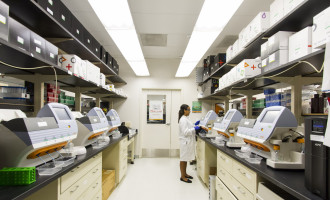
Researchers have developed a method that simultaneously measures different cancer-specific hallmarks of DNA circulating in the blood, aiding early detection and localisation of tumours.
The research, published today as a Reviewed Preprint in eLife, is what the editors describe as a valuable study providing a comprehensive assessment of a newly developed predictive model for detecting cancer and determining the tissue of origin. The authors provide solid evidence and shed insights into the early detection of cancer with non-invasive methods using a large set of patient samples to develop the test and a separate group of patient samples to validate it.
Circulating tumour DNA (ctDNA) in the blood has become a promising biomarker for detecting early-stage cancers because it carries genetic and epigenetic modifications from the original tumour DNA. By detecting specific patterns of these modifications, unique to tumour types and originating tissue, it is possible to identify a corresponding unknown primary cancer and its location. However, existing tests currently lack accuracy in classifying the source of tumour DNA and/or require in-depth gene sequencing which is too costly to apply for wider population screening.
“Despite their great potential, there remain several challenges that ctDNA tests must solve to deliver accessible and reliable clinical adoption for the general population, including the low amount of ctDNA in the blood of early-stage cancer patients, and the diversity in ctDNA from different cancer types, subtypes and stages,” explains co-lead author Van Thien Chi Nguyen, Research Associate at Gene Solutions and the Medical Genetics Institute, Ho Chi Minh City, Vietnam.
“Recent studies have focused on a multi-analyte approach – combining genomic and protein features – but these are also time-consuming and costly. We set out to develop a multi-modal approach that uses several properties of ctDNA to detect and locate cancer from a single screening test,” adds co-lead author, Trong Hieu Nguyen, Senior Data Scientists and PhD at Gene Solutions and the Medical Genetics Institute.
The approach, called SPOT-MAS (Screening for the Presence of Tumor by DNA Methylation and Size), combines targeted high-depth gene sequencing with shallow whole-genome sequencing, to reveal multiple features of the ctDNA. This makes it possible to determine the methylation profiles, DNA copy number, size of ctDNA fragments and the sequence motifs at the end of the fragments – all of which are hallmarks of tumour DNA compared to healthy DNA.
The team used this approach to analyse samples from 738 patients with breast, colorectal, liver, lung and stomach cancer alongside 1,550 healthy participants, and input the results into an algorithm to determine ctDNA signatures for each of the cancer types. They then tested the approach using a different group of 239 patients, each with one of the five cancer types, to see how well it performed in detecting the presence and type of cancer.
They found that SPOT-MAS detected 73% of cancers with 97% accuracy using just the shallow-depth sequencing. Moreover, the test predicted the tissue of origin with 70% accuracy. When they tested models using only one of the features – such as only focusing on DNA copy number – they found that models using multiple features were superior to those using single features. The test was most effective at detecting liver cancer, identifying around 90% of cases, and least effective for breast cancer, where it only detected around half of the cases. This aligns with previous research which suggests liver tumours shed large amounts of ctDNA, compared with breast cancers that shed lower amounts.
Further research is now needed to compare this new approach with existing ctDNA methods to show that it can perform better and is more cost-effective than tests using single features alone. It will also be necessary to evaluate the test in larger groups of patients with earlier stages of cancer than those involved in the current study.
“Our work demonstrates that SPOT-MAS, with its unique combination of ctDNA feature and innovative machine learning algorithms, can successfully detect and localise multiple types of cancer through low-cost sequencing techniques,” concludes senior author Le Son Tran, Principle Investigator and RD team leader at Gene Solutions and the Medical Genetics Institute. “A large, multi-centre prospective study with several years’ follow-up is currently underway to fully validate the performance of SPOT-MAS as an early cancer screening test before it’s considered for use in a wider clinical setting.”
Source: eLife